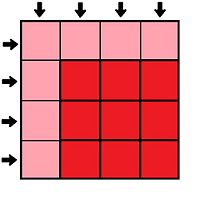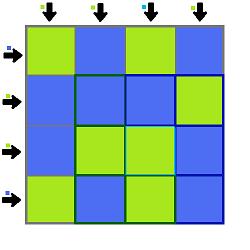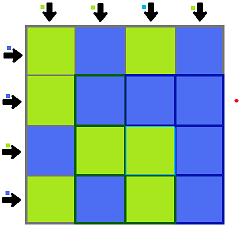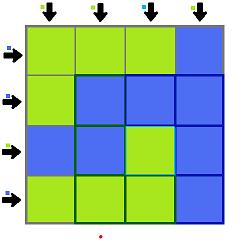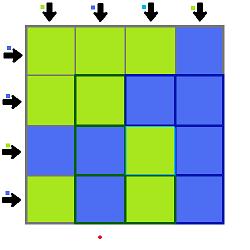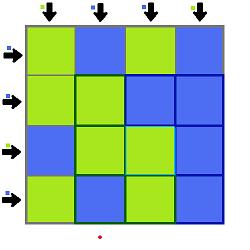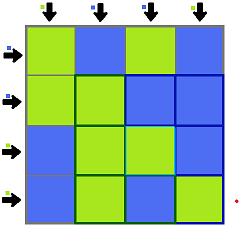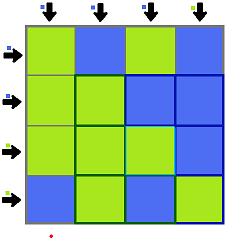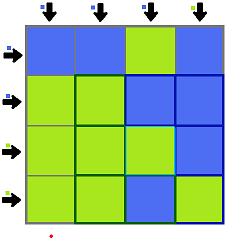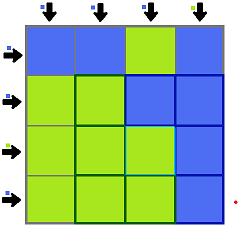GCPP:Proposal-Shiner
Puzzle Codename: Shiner
| Contact | |
| Username: | Melvinpilot |
| Additional contact info: | Jackmist on Sage.
Email at k.n.bluestar@gmail.com for quick response. If you have anything lengthy, please mail to h.21tk2c@gmail.com |
| Project forum thread: | |
Game concept
A game of sliding rows and columns to create patterns. Probably inspired by my fascination of the Rubik's Cube, though I wasn't thinking about it at the time.
Objective
To complete patterns by sliding columns and rows of pieces.
Gameplay
The board is a square grid (4x4, 5x5, etc.). There would be 2 or more types of regular pieces, the number increasing with difficulty.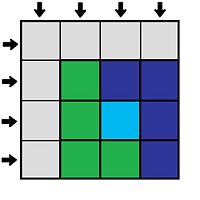
Each row and column in the grid would be able to be shifted by one space every turn, and only in one direction (downwards for the columns, right for the rows). New pieces are added to the grid as the rows and columns are shifted, and as pieces fall off the edge of the grid they are lost. The next piece available would be visible before it is entered into the grid.
The top row and most left column would be a preparation zone. Here, new pieces are added to the board and can be shifted along their line. The rest of the grid would be the destination zone, where pieces must be shifted into their correct order.
Special Pieces
There are a couple special pieces.
Wild This piece can be used as any piece.
Broken If a piece doesn't move for a long enough period (ie. number of rows * 2.5 turns), it will become broken, and therefore must be discarded of by being pushed over the edge.
Match Some pieces will have a way that they can match other pieces (the grain of wood, or a paint splatter-sort of like maneuver tokens in bilging).
Scoring
Low number of moves makes for high points, and pieces being broken subtracts points. The more diverse the rows and columns used, the more points are added. Matching pieces which are matched during the game will add bonus points, and if matched at when the puzzle is completed they add a larger bonus.
Variability
Matching pieces will provide an extra challenge.
End criteria
The game is finished when the pre-designated pattern is completed.
Difficulty scaling
The board itself will be enlarged, more colors will be introduced, and finishing patterns will be more complex. My guess is that 2 colors, a 4x4 board would be the easiest, up to 4 colors, a 7x7 board at extreme difficulties.
Simple Example Game
This is a simple example game, using the piece objective above. There are no special pieces , and a small board (4x4) with only two colors is used. The color next to the arrow is the next color that will come out. The red dot indicates which row or column was moved.
This is the starting board. Pieces are randomly put throughout the board.
The second from the top row is moved, making the left most column all blue. A green piece is pushed off while another green piece enters the board.
The second from the left column is moved. This same move occurs 3 times in a row.
The bottom row is now moved.
The leftmost column is moved twice in a row, to make a green-green-blue pattern on the bottom row.
The bottom row is moved, completing the pattern.
Crafting type
Furnishing
Known problems
If a pattern is too complex, it may become unsolvable to lower level puzzlers, making the game potentially endless. A turn limit, or a "material limit" may be implemented to prevent this. Alternately, the puzzle could "erode" from the edge to be made easier if too much turns have passed.
Notes
I thought of this in the shower, looking at the tiles.
Themes
Some themes that could make this puzzle be a puzzle for furnishing. 1. Have the pieces be materials, such as paint/planks/cloth. 2. When a piece falls off the edge of the board, have an animation appropriate to what fell off. If it was wood, a saw would saw it off, is it was cloth, some scissors cut it, if it was paint, it would fall off... 3. The rows and columns could be a conveyor belt, or something of the sort, moving items along. 4. The patterns could be, as in Shipwrightery, a rough image of a furniture item (no ideas yet, but...)
Images
